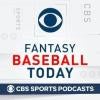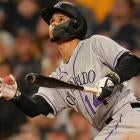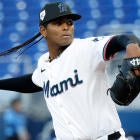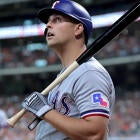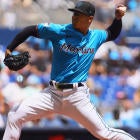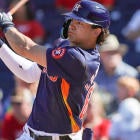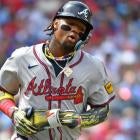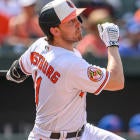About a month ago, we received an email asking us to dive deeper into the advanced stats we reference daily on Fantasy Baseball Today. I can understand how some of the analysis can be confusing, even intimidating at times. Heck, sometimes even I can't wrap my head around all the numbers. Ultimately, while we want to help you win your Fantasy leagues by analyzing specific players, we also want to help you understand how we come to those conclusions ourselves. Understand the how and why players do what they do is truly remarkable.
That holds especially true for pitching. While I could have included 50 stats below, I limited this piece to 12 because I don't want your heads to explode, plus I'd probably end up writing for a few more days. Throughout the adventure below, you'll hear me reference stats Chris Towers has already described from a hitter's perspective. Truth be told, most if not all the stats Chris described translate to pitchers as well. If you've ever heard the term "regression" for a pitcher, there's a good chance it was described using one of the stats below:
FIP
What does it mean? Fielding Independent Pitching. FIP is an ERA estimator that is based on outcomes that do not involve defense, i.e., strikeouts, walks, hit by pitches and home runs allowed. FIP approximates what a pitcher's ERA would be assuming average outcomes on balls in play.
Why does it matter? Not all defenses are created equally. Chris explained BABIP in the hitter advanced stats, but it matters for pitchers, too. Pitchers have very little control over BABIP once a ball is in play. What FIP does is eliminate that. Some pitchers have a great defense behind them, others are not so fortunate. The mistake people make is assuming that just because a pitcher has a FIP lower than their ERA, that pitcher will improve. While he should improve and his FIP reveals said pitcher has been unlucky, it's still dependent on the team playing at least league average defense. Not every team can do that.
Some key results from 2019:
| | 10th %ile | 50th %ile | 90th %ile |
FIP | 4.85 | 4.11 | 3.10 |
Example |
Zach Eflin pitched to a 4.13 ERA last season but his 4.85 FIP was much higher. Why is that? Remember, FIP estimates what Eflin's ERA would be with league-average defense. The Phillies ranked eighth in defensive runs saved last season, which tells us they were a pretty strong defense. The same could be said for Ryu, who owned a 2.32 ERA but his 3.10 FIP was considerably higher. Well, the Dodgers ranked first in DRS last season. Ryu's new team, the Blue Jays, ranked just 19th.
Where can you find it? FanGraphs.com has it on every player's page under "dashboard", along with yearly and career leaderboards.
xFIP
What does it mean? Expected Fielding Independent Pitching. xFIP is an ERA estimator, like FIP, except better. xFIP is also based on outcomes that do not involve defense, i.e., strikeouts, walks, hit by pitches, and fly balls allowed. The difference is xFIP approximates what a pitcher's ERA would be assuming average outcomes on balls in play and a league average HR/FB ratio.
Why does it matter? xFIP is my favorite ERA estimator to use. While none of them are perfect, I like the things xFIP factors in the most. xFIP takes all things FIP takes into account except it adds more context. There are many variables that go into home runs. How often a fly ball turns into a home run isn't always in the hands of the pitcher. The wind could be blowing out at Wrigley that day. He could be making a start in Yankee Stadium. Like defense, not every home run is created equally. That's why we have what people consider hitter's parks and pitcher's parks. xFIP is a bit more predictive than FIP, but problems still remain. For somebody like Masahiro Tanaka, his xFIP is routinely lower than his ERA. However, he consistently posts high HR/FB ratios because he pitches in Yankee Stadium. That this tells us is that if he pitched in Oracle Park, his ERA might be closer to his xFIP.
Some key results from 2019:
| | 10th %ile | 50th %ile | 90th %ile |
xFIP | 5.10 | 4.29 | 3.23 |
Example | Masahiro Tanaka |
Anibal Sanchez posted a respectable 3.85 ERA with the Nationals last season, but his 5.10 xFIP tells us a different story. First of all, Sanchez walks too many and doesn't generate enough strikeouts to support an ERA that low. On top of that, he allowed more fly balls (39%) than ground balls (38%). Based on the amount of fly balls he allowed, his ERA should have been closer to that 5.10 mark.
Where can you find it? FanGraphs.com has it on every player's page under "dashboard", along with yearly and career leaderboards.
SIERA
What does it mean? Skill-Interactive ERA. Like xFIP, SIERA is another ERA estimator, except different. While FIP and xFIP try to eliminate balls in play, SIERA considers groundball rate alongside strikeouts and walks.
Why does it matter? If xFIP is my most used ERA estimator, then SIERA is second. These ERA estimators continue to evolve and that's where SIERA enters the conversation. While FIP and xFIP estimate what an ERA should look like in controlled environments, SIERA estimates ERA while including groundball rate. SIERA calculates ERA and shows us how run prevention improves as a pitcher increases groundball and strikeout rates and decreases walk rates. Like FIP and xFIP, SIERA calculates what an ERA should be based on events that have taken place and isn't necessarily a predictive stat.
Some key results from 2019:
| | 10th %ile | 50th %ile | 90th %ile |
SIERA | 5.11 | 4.31 | 3.49 |
Example |
Wow, Julio Teheran. Where do I begin? Teheran has become the poster child for outperforming these ERA estimators, and there will be outliers like him. He's the perfect example of why these estimators aren't predictive. If they were, his 3.67 career ERA would be a lot closer to his 4.27 career SIERA. Basically, the problem for Teheran is that he walks too many and is a fly ball pitcher. Remember, SIERA awards those who generate ground balls. The reason why Justin Verlander has been able to survive this offensive environment is because he barely walks anybody. He allows a decent amount of home runs, but a lot of those are solo homers. The more players you walk, the more home runs will hurt.
Where can you find it? FanGraphs.com has it on every player's page under "batted ball", along with yearly and career leaderboards.
xERA
What does it mean? Expected ERA. xERA is our final ERA estimator for today, but is slightly different. xERA also takes strikeouts, walks and hit by pitches into account, but also considers the quality of contact, mainly exit velocity and launch angle.
Why does it matter? With the ever-growing popularity of Statcast data, it only makes sense that we have an ERA estimator that accounts for such data. All of the other ERA estimators that we have take different things into account. For FIP, it's defense. For xFIP, it's defense and HR/FB ratio. For SIERA, it's groundball rate. xERA uniquely estimates what an ERA should look like based on batted ball data provided on Statcast. It's an alternative to the others but should be used in conjunction.
Some key results from 2019:
| | 10th %ile | 50th %ile | 90th %ile |
xERA | 5.33 | 4.29 | 3.33 |
Example |
If you pull up Brett Anderson's Statcast page, you'll see a ton of blue dots. Those are bad. While Anderson pitched to a 3.89 ERA in 2019, he owned a 5.33 xERA because he allowed a ton of hard contact and barely generated any swings and misses. Unless Anderson begins to strike out more batters, we should project for a higher ERA this season.
Where can you find it? Baseballsavant.com has it on every player's page under "statcast", along with expected statistics leaderboard.
K/9 or SO/9
What does it mean? Strikeouts Per Nine Innings. This is just a different way of measuring strikeouts. K/9 tells us how many strikeouts a pitcher averages for every nine innings pitched.
Why does it matter? It's an alternative when measuring a pitcher's ability to strike batters out. Some prefer strikeout rate (K%) but many use K/9 when analyzing pitchers. Just looking at a pitcher's strikeout total is misleading because of injury or usage. For example, Chris Sale's 218 strikeouts ranked 18th among starting pitchers last season, but his 13.32 K/9 ranked second (minimum 140 innings pitched).
Some key results from 2019:
| | 10th %ile | 50th %ile | 90th %ile |
K/9 | 6.64 | 8.65 | 11.56 |
Example |
Brad Keller's 6.64 K/9 in 2019 led to a less-than-stellar 4.19 ERA (his 4.94 xFIP tells it could have been even worse). Strikeouts are not the end-all, be-all, but the less a ball is put in play, the better it is for a pitcher. Why leave it to chance? There's a lot of luck involved in baseball. Pitchers can also be successful with a low K/9; they just need to limit walks and induce soft contact. Kyle Hendricks is the poster child in that regard.
Where can you find it? FanGraphs.com has it on every player's page under "dashboard", along with yearly and career leaderboards.
BB/9
What does it mean? Walks Per Nine Innings. This is just a different way of measuring walks. BB/9 tells us how many walks a pitcher averages for every nine innings pitched.
Why does it matter? It's an alternative when measuring a pitcher's ability to limit walks. Some prefer walk rate (BB%) but many use BB/9 when analyzing pitchers. Sometimes it makes sense to walk a dangerous batter if there's a base open and the situation calls for it, but for the most part walks are bad for pitchers. They increase pitch counts, which limits a pitcher's ability to go deeper into games and they put runners on base for free. The main objective in baseball is to keep the opposition off base. Shame on you, Robbie Ray, and your egregious 4.34 BB/9.
Some key results from 2019:
| | 10th %ile | 50th %ile | 90th %ile |
BB/9 | 3.69 | 2.55 | 1.70 |
Example | Justin Verlander |
Like strikeouts, walks are not the only thing that matter while pitching. Limiting them, however, helps. Of the 13 qualified starting pitchers with <2.00 BB/9, eight of them had a sub-3.50 ERA. As mentioned earlier, Justin Verlander struggles with home runs, but because he walks so few batters, he can survive allowing solo shots.
Where can you find it? FanGraphs.com has it on every player's page under "dashboard", along with yearly and career leaderboards.
K-BB%
What does it mean? Strikeout-Minus-Walk Percentage. In literal terms, it's strikeout percentage (strikeouts/total batters faced) minus walk percentage (walks/total batters faced). If you've ever heard of strikeout-to-walk ratio, this is a similar way of measuring that.
Why does it matter? Measuring the difference of strikeouts and walks is important for pitchers. This is just a more efficient, easier way to read that. Rather than saying "Hyun-Jin Ryu had a 163-24 strikeout-to-walk ratio", you can just say 19.2% K-BB percentage.
Some key results from 2019:
| | 10th %ile | 50th %ile | 90th %ile |
K-BB% | 9.2% | 16.4% | 24.3% |
Example |
This one is pretty simple. The higher the number, the better. Part of Lucas Giolito's transformation has been the ability to dramatically improve his strikeout rate while lowering his walk rate. More strikeouts and less walks is optimal for any pitcher. Unless of course, you're John Rocker.
Where can you find it? FanGraphs.com has it on every player's page under "advanced", along with yearly and career leaderboards.
LOB%
What does it mean? Left-On-Base Percentage. Also known as strand rate, left-on-base percentage measures how many runners a pitcher leaves on base when recording an out.
Why does it matter? Like the ERA estimators, LOB% could be used to figure out regression for pitchers. If a pitcher is off to a hot start with an incredibly low ERA and 90% LOB%, that number usually regresses towards the mean, which leads to more runners scoring while on base. The same could be said for the inverse if a pitcher goes through a cold stretch where his LOB% is lower than it should be.
Some key results from 2019:
| | 10th %ile | 50th %ile | 90th %ile |
LOB% | 68.9% | 74.9% | 81.8% |
Example | Anibal Sanchez |
If healthy this season, Noah Syndergaard would have been a player you could buy-low on in drafts because of his 68.9% LOB%, which ranked in the 10th percentile last season. As a result, he pitched to a 4.28 ERA when in all likelihood, he should have stranded more runners and pitched closer to a sub-4.00 ERA.
Where can you find it? FanGraphs.com has it on every player's page under "dashboard", along with yearly and career leaderboards.
O-Swing%
What does it mean? Outside Swing Percentage. Also known as chase rate, O-swing% measures swings at pitches outside the zone divided by pitches outside the zone. Basically, it's how often a pitcher gets a batter to chase pitches.
Why does it matter? While K/9, BB/9 and ERA estimators are fun, now we're getting into the nitty gritty. O-swing% represents more of the "how" when it comes to a pitcher. How did a pitcher get all those strikeouts? Well, were they getting opposing batters to chase pitches outside the zone? It can only be a positive. Being able to finish a hitter off by getting him to chase a pitch out of the zone is one of the paramount foundations of being a successful pitcher.
Some key results from 2019:
| | 10th %ile | 50th %ile | 90th %ile |
O-Swing% | 29.3% | 33.5% | 36.4% |
Example |
This is part of what has made Jose Berrios so frustrating the past few seasons. While he's been serviceable, we're still waiting for him to take that next step. His upside is tantalizing. Well, based on his career-high 36.4% O-swing% in 2019, it seems like Berrios is ready. He has all the tools. He just has to put the pieces together for an entire season.
Where can you find it? FanGraphs.com has it on every player's page under "plate discipline", along with yearly and career leaderboards.
F-Strike%
What does it mean? First Pitch Strike Percentage. F-Strike% is first pitch strikes divided by plate appearances. Basically, how often does a pitcher start off with an 0-1 count.
Why does it matter? F-Strike% is useful in conjunction of with O-Swing% and the next stat we'll discuss, SwStr%. Any pitcher who can get ahead in the count, rack up swinging strikes and get batters to chase pitches out of the strike zone at an above average rate, is going to have some level of success. The first part of that equation is, of course, generating strike one in an 0-1 count.
Some key results from 2019:
| | 10th %ile | 50th %ile | 90th %ile |
F-Strike% | 57.2% | 63.5% | 67.4% |
Example | Eduardo Rodriguez |
While Clayton Kershaw doesn't have the "stuff" he once did, you can still depend on him having good command and attacking hitters early in the count. This is something he's actually done well his entire career. Some guys lack the confidence or command to establish the strike zone early, and while you don't want to be too predictable and groove the first pitch, it's beneficial to get ahead early.
Where can you find it? FanGraphs.com has it on every player's page under "plate discipline", along with yearly and career leaderboards.
SwStr%
What does it mean? Swinging Strike Percentage. SwStr% is swings and misses divided by total pitches. Swings and misses equals money in Fantasy Baseball.
Why does it matter? SwStr% is the granddaddy of them all. We want a high K/9. We want a high K-BB%. How do we get there? Swinging strikes! The ability to generate swinging strikes goes a long way for both real-life and Fantasy performance. There's a clear correlation between swinging strikes and high strikeout rates in baseball. In other words, the higher the swinging strike rate, the better.
Some key results from 2019:
| | 10th %ile | 50th %ile | 90th %ile |
F-Strike% | 8.0% | 10.9% | 15.0% |
Example | Sandy Alcantara | Lucas Giolito |
Ah, Lucas Giolito. We meet again. While some may be skeptical of Giolito because he's only performed at an elite level for one season, you need to know that he was really elite in 2019. After changing up his mechanics and developing his changeup, Giolito went through a massive transformation that helped him achieve new heights across the board. His newfound ability to rack up swinging strikes went a long way in his success.
Where can you find it? FanGraphs.com has it on every player's page under "plate discipline", along with yearly and career leaderboards.
CSW
What does it mean? Called Strikes Plus Whiffs. CSW is called strikes plus whiffs divided by total pitches. Notice we haven't touched on called strikes yet, well here's why.
Why does it matter? Thanks to our friends over at Pitcher List, CSW is now a thing… and it should be. Basically, this metric measures the ability for a pitcher to generate a strike, regardless of how it happens. While swinging strikes are invaluable, it's become evident that CSW is actually more predictive in terms of ERA and strikeout rate. Don't believe me? Let Alex Fast break it down for you.
Some key results from 2019:
| | 10th %ile | 50th %ile | 90th %ile |
CSW | 25.8% | 28.4% | 32.2% |
Example | Stephen Strasburg |
Stephen Strasburg consistently ranks high in strikeout rate and K/9. He's posted at least a 10.13 K/9 for a ridiculous six straight seasons. How do you consistently strike out that many batters? Well, I'm sure ranking in the 90th percentile in CSW doesn't hurt. Like all the other metrics mentioned here today, they're used as supporting evidence. Do you want to find out if a pitcher's strikeout rate is legitimate? Seeing if they rank highly in CSW is one way to find out.
Where can you find it? Pitcherlist.com has it on their leaderboard under the "overview" tab.
So which sleepers should you snatch in your draft? And which undervalued first baseman can help you win a championship? Visit SportsLine now to get rankings for every single position, all from the model that called Kenta Maeda's huge breakout last season, and find out.








